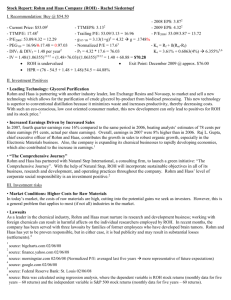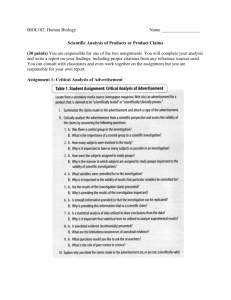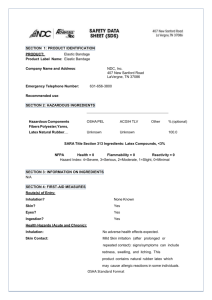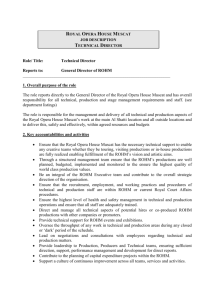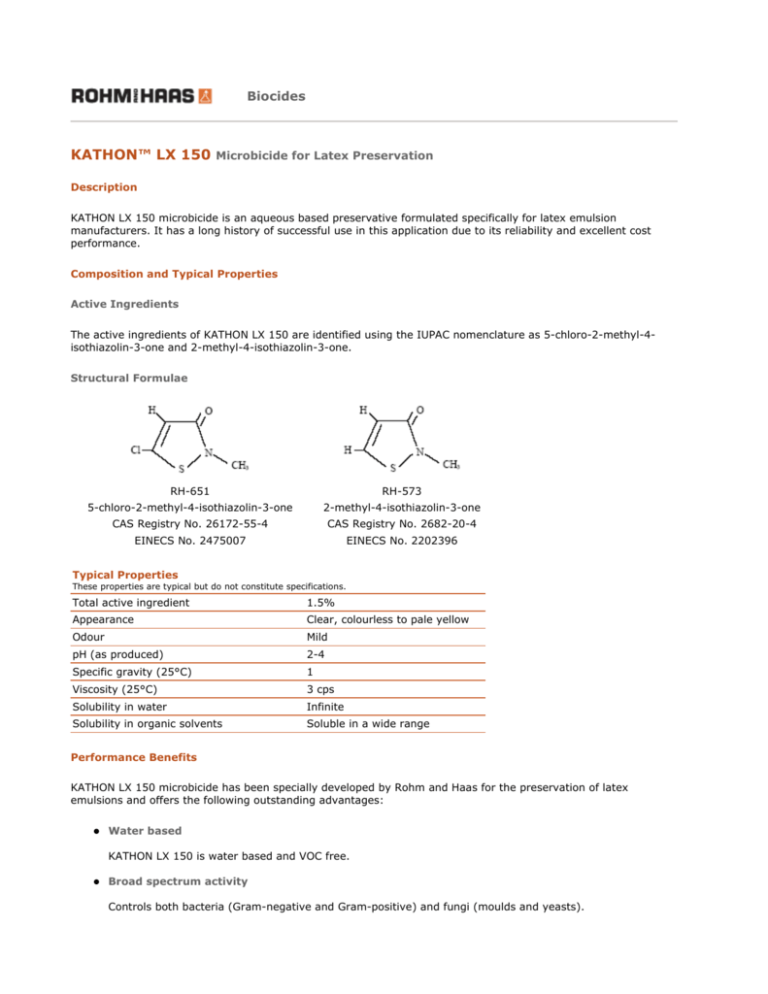
Biocides
KATHON™ LX 150 Microbicide for Latex Preservation
Description
KATHON LX 150 microbicide is an aqueous based preservative formulated specifically for latex emulsion
manufacturers. It has a long history of successful use in this application due to its reliability and excellent cost
performance.
Composition and Typical Properties
Active Ingredients
The active ingredients of KATHON LX 150 are identified using the IUPAC nomenclature as 5-chloro-2-methyl-4isothiazolin-3-one and 2-methyl-4-isothiazolin-3-one.
Structural Formulae
RH-651
RH-573
5-chloro-2-methyl-4-isothiazolin-3-one
2-methyl-4-isothiazolin-3-one
CAS Registry No. 26172-55-4
CAS Registry No. 2682-20-4
EINECS No. 2475007
EINECS No. 2202396
Typical Properties
These properties are typical but do not constitute specifications.
Total active ingredient
1.5%
Appearance
Clear, colourless to pale yellow
Odour
Mild
pH (as produced)
2-4
Specific gravity (25°C)
1
Viscosity (25°C)
3 cps
Solubility in water
Infinite
Solubility in organic solvents
Soluble in a wide range
Performance Benefits
KATHON LX 150 microbicide has been specially developed by Rohm and Haas for the preservation of latex
emulsions and offers the following outstanding advantages:
z Water based
KATHON LX 150 is water based and VOC free.
z Broad spectrum activity
Controls both bacteria (Gram-negative and Gram-positive) and fungi (moulds and yeasts).
z Rapid inhibition of microbial growth and enzyme synthesis
KATHON LX 150 microbicide causes immediate inhibition of growth on coming in contact with a
microorganism. The growth inhibition rapidly becomes irreversible and results in cell death. Even before cell
death occurs, the organism treated with KATHON LX 150 microbicide is unable to synthesize enzymes.
z Economical
Use concentrations are more cost-effective than other commercial latex preservatives.
z Formaldehyde-free
Does not contain or generate formaldehyde.
z Low toxicity
Extensive toxicological testing has shown that the active ingredients of KATHON LX 150 are safe at
recommended use levels in your final formulation.
z Low use levels
The powerful active ingredients in KATHON LX 150 make it effective at low use levels.
z Biodegradable/non-persistent in the environment
Readily dissipated in the environment by chemical, biological and physical means. Active ingredient
breakdown does not lead to the presence of chlorinated organics in the environment.
z Easy to incorporate into latex emulsions.
z Compatibility
Compatible with surfactants and emulsifiers, regardless of their ionic nature.
Efficacy: Minimum Inhibitory Concentration Data
The following table indicates the minimum concentrations in parts per million (ppm) of KATHON LX 150, as
supplied, which inhibit the growth of various microorganisms in test tube cultures. These data demonstrate broad
spectrum antimicrobial activity. The methods used to obtain the data are useful tools for screening anti-microbial
materials under standardized laboratory conditions, in nutrient-rich growth media. Concentrations will vary with
changes in media and testing conditions.
Test Organism
ATCC Number
Product (ppm)
Active Ingredient (ppm)
Bacillus cereus var.mycoides
R&H#L5
133
2.0
Bacillus subtilis
R&H#B2
133
2.0
Brevibacterium ammoniagenes
6871
133
2.0
Staphylococcus aureus
6538
133
2.0
Alcaligenes faecalis
8750
133
2.0
Enterobacter aerogenes
3906
333
5.0
11229
527
7.9
958
593
8.9
Gram positive bacteria*
Gram negative bacteria*
Escherichia coli
Flavobacterium suaveolens
Proteus vulgaris
8427
333
5.0
Pseudomonas aeruginosa
15442
333
5.0
Pseudomonas fluorescens
13525
133
2.0
Yeasts*
Candida albicans
11651
333
5.0
Rhodotorula rubra
9449
133
2.0
Saccharomyces cerevisiae
2601
133
2.0
Alternaria dianthicola
11782
193
2.9
Aspergillus foetidus
16878
527
7.9
Aspergillus oryzae
10196
333
5.0
Fungi
Aureobasidium pullulans
9294
400
6.0
Cladosporium resinae
11274
333
5.0
Fusarium oxysporum
R&H-EL-1
267
4.0
9644
333
5.0
USDA
133
2.0
R&H-SH-2
133
2.0
Penicillium funiculosum
Penicillium variabile
Trichosporon sp.
* The organisms in these categories have been isolated from contaminated latex emulsions
Directions for Use
Freshly prepared latex emulsions can be reactive mixtures, which makes it difficult to predict accurately the
stability and therefore efficacy of a biocide. It is therefore recommended that for each latex emulsion stability and
efficacy testing is carried out to optimise biocide dosing.
Dosing Recommendations
Extensive laboratory testing and field experience with the product shows that optimal use levels are between 0.1%
and 0.2% product as supplied (15 - 30 ppm active ingredient).
For Sensitive Formulations: KATHON LX 150 is used directly in the majority of latex emulsions. It is also used for
formulation prone to gelling.
Regulatory Status of KATHON LX 150
The list below is intended to assist you in complying with prevailing regulatory controls. It lists the status of
KATHON LX 150 in those countries where specific approval is required.
Country
Product
Regulatory
Clearance
Germany
The active ingredients
in KATHON LX 150
BgVV Rec. XIV
BgVV Rec. XXXVI
Application
As a preservative of polymer emulsions for the
coating of food contact articles and general articles,
with a maximum of 0.004 mg/dm2.
As a slimicide in the manufacture of paper, carton
and cardboard designated for food-contact with a
maximum of 0.0004% relative to the dry fibre. In
the extract of the final product the maximum
detectable concentration must not exceed
0.0005 mg/dm2.
BgVV Rec. XXXVI/I
As a slimicide in the manufacture of cooking and hot
filter papers and filter layers designated for: hot
extraction e.g. cooking bags, teabags, hot
filterpapers, and filter layers designated for
extraction (filtration) at a maximum of 4 mg/kg
relative to the dry fibre. In the hot water extract of
the final product the maximum detectable
concentration must not exceed 0.0005 mg/dm2.
BgVV Rec. XXXVI/2
As a slimicide in the manufacture of paper, carton
and cardboard for baking purposes designated for
food-contact at a maximum of 0.0004% relative to
the dry fibre. In the hot water extract of the final
product the maximum detectable concentration must
not exceed 0.0005 mg/dm2.
These clearances apply only to KATHON LX 150 as submitted by Rohm and Haas Company. Formulations containing other ingredients may
need to be resubmitted for approval.
Country
Product
Regulatory
Clearance
Application
Italy
The active ingredients
in KATHON LX 150
Decree No. 395
August 1987
Belgium
The active ingredients
in KATHON LX 150
The formulation containing these active ingredients
can be used in food-contact applications provided
the specific migration limit (SML) of 0.01 mg/kg for
each active ingredient is respected.
Holland
The active ingredients
in KATHON LX 150
The formulation containing these active ingredients
with taking into account the specific migration limits
of these active ingredients can be used in the
process water during the manufacturing of paper and
board as defined in the WARENWET.
USA
The active ingredients
in KATHON LX 150
Food contact paper
FDA21CFR-175.105
Adhesives. Limitations - for use only as an
antimicrobial agent in polymer latex emulsions.
FDA21CFR-175.170
Component of paper and paperboard in contact with
aqueous and fatty foods. Limitations - for use only:
1. As an antimicrobial agent for polymer latex
emulsions in paper coatings at a level not to exceed
50 ppm (active ingredient) in the coating
formulation.
2. As an antimicrobial agent for finished coating
formulations and for additives used in the
manufacture of paper and paperboard including
fillers, binders, pigment slurries and sizing solutions
at a level not to exceed 25 ppm (based on active
ingredient) in the coating formulation and additives.
FDA21CFR-176.180
Components of paper and paperboard in contact with
dry food. Limitations - same as specified under
21CFR-176.170.
These clearances apply only to KATHON LX 150 as submitted by Rohm and Haas Company. Formulations containing other ingredients may
need to be resubmitted for approval.
Plant Hygiene
The preservation of latex emulsions should be achieved through a combination of an effective biocide and good
quality control. Biocide addition should not be used to replace good hygiene; it is complementary to good
manufacturing practice, not a substitute for it. Some of the key aspects of preventing microbial contamination are
given below.
z Raw Materials
- Are they susceptible to microbial contamination?
- Regularly monitor their microbiological quality
- Set a microbiological specification for them
z Process Water
- Monitor the microbial contamination level
- Regularly clean and sanitise water treatment units
- Treat stored water prior to use
z Storage and Handling
-
Flush and drain lines when not in use
Clean and sanitise lines and equipment regularly
Try to minimise dead or non-draining areas
Clean and sanitise reused drums and containers
Avoid entry of ambient air into storage tanks
Minimise tank headspace and/or provide microbe free headspace
z Cleaning and Sanitisation
- Establish protocols for cleaning and sanitising of tanks and equipment.
Detailed suggestions and guidance regarding plant hygiene are given in our bulletin, "Preventing Microbial
Contamination in Manufacturing," which is available from your local Rohm and Haas sales office.
Toxicology and Environmental Fate
Rohm and Haas Company takes every measure to ensure that its products are safe for both man and the
environment.
Toxicology
In line with this policy, Rohm and Haas can provide comprehensive toxicological data for KATHON LX 150, which
shows it is of low toxicity at recommended use levels. More detailed information on the toxicological profile of
KATHON LX 150 can be obtained from your local Rohm and Haas sales office.
Environmental Fate
There is no short cut to environmental safety: Rohm and Haas has conducted extensive research into the
environmental fate of the active ingredients of KATHON LX 150.
These studies demonstrate that at normal use/dilution levels KATHON LX 150 has minimal environmental impact
because of the following properties:
z High performance product used at very low use levels
z Rapid degradation to non-toxic, non-persistent substances
z Degradation does not produce chlorine or chlorinated organics
z Does not affect the performance of waste water treatment plants
This combination of properties makes KATHON LX 150 the environmentally sound choice for the preservation of
latex emulsions.
Material Safety Data Sheets
Rohm and Haas company maintains Material Safety Data Sheet (MSDS) on all of its products. These contain
important information that you may need to protect your employees and customers against any known health and
safety hazards associated with our products. We recommend you obtain copies of MSDS for our products from
your local Rohm and Haas technical representative or the Rohm and Haas company. In addition, we recommend
you obtain copies of MSDS from your suppliers of other raw materials used with our products.
These suggestions and data are based on information we believe to be reliable. They are offered in good faith, but without guarantee, as
conditions and methods of use of our products are beyond our control. We recommend that the prospective user determines the suitability of
our materials and suggestions before adopting them on a commercial scale.
Suggestions for uses of our products or the inclusion of descriptive material from patents and the citation of specific patents in this
publication should not be understood as recommending the use of our products in violation of any patent or as permission or license to use
any patents of the Rohm and Haas Company.
KATHON is a registered trademark of Rohm and Haas Company or of its subsidiaries or affiliates.
©Rohm and Haas, 2007
All rights reserved.
October 2002
KATHON LX 150.PB.E.10/2002.



